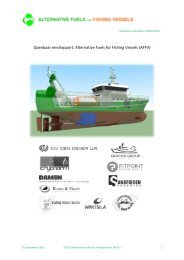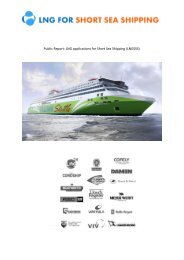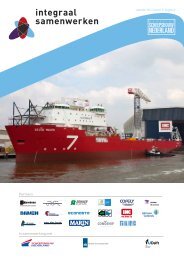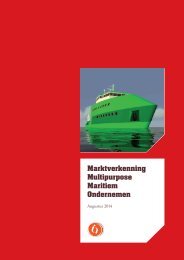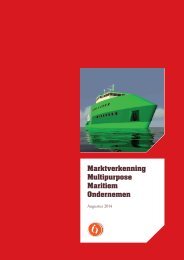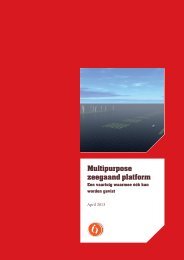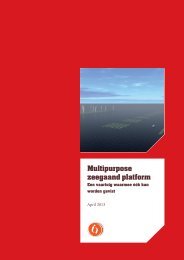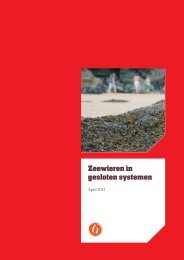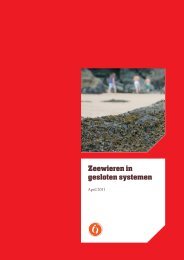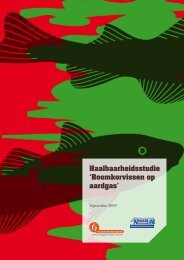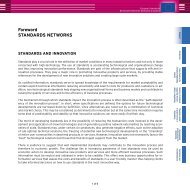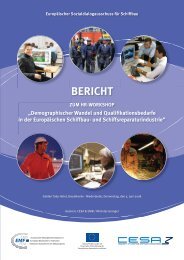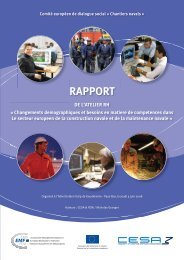Summary: Feasibility study into gas-driven beam trawling (2009)
A study into the technical, logistical and economical feasibility of Liquid Natural Gas (LNG) as an alternative fuel for fishing vessels.
A study into the technical, logistical and economical feasibility of Liquid Natural Gas (LNG) as an alternative fuel for fishing vessels.
Create successful ePaper yourself
Turn your PDF publications into a flip-book with our unique Google optimized e-Paper software.
Haalbaarheidsstudie<br />
‘Boomkorvissen op<br />
aard<strong>gas</strong>’<br />
September <strong>2009</strong>
Haalbaarheidsstudie<br />
‘Boomkorvissen op<br />
aard<strong>gas</strong>’<br />
Dit rapport is in opdracht van InnovatieNetwerk opgesteld door:<br />
Ir. P. ’t Hart, Koers & Vaart BV<br />
Projectleider:<br />
Drs. H.J. Riphagen (InnovatieNetwerk)<br />
Dit rapport is opgesteld in het kader van het thema ‘Duurzaam Ondernemen’,<br />
concept ‘Noordzeevisserij: naar nieuwe energie’.<br />
Postbus 19197 Postbus 30145<br />
3501 DD Utrecht 3001 DC Rotterdam<br />
tel.: 070 378 56 53 tel.: 010 20527720<br />
www.innovatienetwerk.org<br />
www.dutch-maritime-network.nl<br />
Het ministerie van LNV nam het initiatief tot<br />
en financiert InnovatieNetwerk.<br />
ISBN: 978 - 90 - 5059 - 399 - 1<br />
Overname van tekstdelen is toegestaan, mits met bronvermelding.<br />
Rapportnr. 09.2.217, Utrecht, september <strong>2009</strong>.
Voorwoord<br />
Nederland Maritiem Land en InnovatieNetwerk hebben<br />
samen de opdracht gegeven voor deze haalbaarheidsstudie.<br />
We hebben namelijk het idee dat het gebruik van aard<strong>gas</strong><br />
bij de voortstuwing van (vissers)schepen in potentie heel<br />
interessant is. Bij een hoge <strong>gas</strong>olieprijs zoekt de visser naarstig<br />
naar goedkopere alternatieven, en aard<strong>gas</strong> is de laatste jaren<br />
aanzienlijk goedkoper dan olie. Bovendien is dit een schone<br />
brandstof met veel lagere emissies, hetgeen politiek steeds<br />
hoger op de agenda komt te staan.<br />
Consultant Pieter ’t Hart van Koers & Vaart BV heeft in dit rapport<br />
de ombouw van een bestaande boomkorkotter beschreven. Hij<br />
schenkt daarbij aandacht aan de technische aspecten van een<br />
ombouw van een schip van 42 meter lang − de Aard<strong>gas</strong>-1 (AG-1)<br />
op <strong>gas</strong> − maar gaat ook uitvoerig in op de economische kant<br />
en op de verkrijgbaarheid van aard<strong>gas</strong> als motorbrandstof. De<br />
beste technische oplossing lijkt om aard<strong>gas</strong> in vloeibare vorm<br />
(LNG) op te slaan in twee onderdeks geplaatste 20 voet cryogene<br />
containers. De bestaande dieselmotor kan met enkele beperkte<br />
ingrepen worden omgebouwd tot een dual fuel-motor, die deels<br />
op <strong>gas</strong> en deels op <strong>gas</strong>olie loopt. Belangrijkste knelpunt is de<br />
verkrijgbaarheid van LNG, maar dat lijkt een kwestie van tijd te<br />
zijn. De kosten van de ombouw zijn met een investeringsimpuls<br />
van de overheid binnen drie jaar terug te verdienen.<br />
Rest ons nog om enkele vissers te bedanken voor hun nuttige<br />
commentaar bij de voortgang van dit onderzoek. Pieter Louwe<br />
van Slooten, Cees van de Berg, Gert-Jan Kooij en Klaas-Jelle<br />
Koffeman hebben de onderzoeker geholpen om een realistische<br />
case te bouwen. We wensen u veel leesplezier met dit rapport<br />
en hopen dat het u inspireert om hier verder over na te denken.<br />
Dr. G. Vos,<br />
Prof.<br />
dr.ir. N. Wijnolst,<br />
Directeur InnovatieNetwerk<br />
Voorzitter<br />
Nederland Maritiem Land
<strong>Summary</strong><br />
87<br />
<strong>Feasibility</strong> <strong>study</strong> <strong>into</strong> <strong>gas</strong>-<strong>driven</strong> <strong>beam</strong> <strong>trawling</strong><br />
Hart, P. ‘t (Koers & Vaart BV);<br />
InnovationNetwork Report No 09.2.217, Utrecht, The Netherlands,<br />
August <strong>2009</strong>.<br />
The Dutch Maritime Network Foundation and InnovationNetwork<br />
jointly performed this feasibility <strong>study</strong> <strong>into</strong> <strong>gas</strong>-<strong>driven</strong> <strong>beam</strong> <strong>trawling</strong>.<br />
Gas has become cheaper than oil in recent years and is abundantly<br />
available. So could <strong>gas</strong> be an attractive alternative fuel for oil? The big<br />
question concerned the feasibility of converting fishing vessels from <strong>gas</strong><br />
oil to natural <strong>gas</strong>. And by feasible we mean three things: is conversion<br />
technically possible, is (liquid) <strong>gas</strong> sufficiently available, and can the<br />
fisherman recoup the investment within a reasonable space of time?<br />
Pieter ’t Hart of Koers & Vaart BV conducted this research for us on<br />
the basis of an existing typical 42-metre-long <strong>beam</strong> trawler currently<br />
active in the Dutch North Sea Fisheries Sector. Can this ship, the<br />
Aard<strong>gas</strong> 1 (AG-1), be converted from <strong>gas</strong> oil to natural <strong>gas</strong>? And can<br />
this be done within the construction and safety requirements of the<br />
inspection & certification agency (the Inspectorate of Transport,<br />
Public Works and Water Management) which largely follows the<br />
guidelines of the International Maritime Organization (IMO)? IMO<br />
has developed a specific code, named ‘bulk liquid and <strong>gas</strong>es<br />
(IMO-BLG)’, that <strong>gas</strong>-<strong>driven</strong> ships must satisfy.<br />
How is <strong>gas</strong> stored on board?<br />
Though cleaner than <strong>gas</strong> oil, natural <strong>gas</strong> has a much smaller per-litre<br />
energy content. If you fuel up with compressed natural <strong>gas</strong> (CNG),<br />
you need five times the volume to fish the same number of hours at
88 sea. With liquid natural <strong>gas</strong> (LNG), however, you need only twice the<br />
volume. Which is why we opted in this <strong>study</strong> for liquid <strong>gas</strong> stored at a<br />
temperature of minus 162 degrees in special twenty-foot cryogenic<br />
containers. A normal fishing week requires two full cryogenic containers.<br />
The best place for these two containers is below decks: transverse<br />
installation in the net storage area seems a feasible option.<br />
Can the existing engine run on LNG?<br />
There is still little experience with <strong>gas</strong> engines on relatively small ships,<br />
such as fishing vessels. It was found that current ship engines are not<br />
technically capable of burning 100% <strong>gas</strong>. But a mixture consisting of a<br />
maximum of 70% <strong>gas</strong> and 30% <strong>gas</strong> oil is perfectly possible. The existing<br />
engine can be converted <strong>into</strong> a dual-fuel engine. Engines manufactured<br />
by Caterpillar are currently the most suitable type for this purpose. The<br />
engine conversion involves placing a <strong>gas</strong> train and installing an electronic<br />
engine management system. Other requirements are a vaporizer for<br />
transforming the liquid LNG back <strong>into</strong> <strong>gas</strong>, a filling system and adequate<br />
safety measures. All these seem technically feasible.<br />
Is natural <strong>gas</strong> sufficiently available?<br />
At present, LNG cannot be obtained as an engine fuel in the Netherlands.<br />
The nearest supplier is based in Zeebrugge in Belgium.<br />
However, a large natural <strong>gas</strong> terminal is being built on the Maasvlakte<br />
(Port of Rotterdam) and is due to be operational in late 2011. This<br />
so-called Gate Terminal is designed to reconvert LNG <strong>into</strong> <strong>gas</strong> and<br />
pump it <strong>into</strong> the pipeline network. Other plans for LNG terminals are<br />
still on the drawing board. The government could stimulate suppliers<br />
to deliver LNG as a fuel for combustion engines. Such measures are<br />
conceivable in the future. Clearly, the municipalities must also cooperate<br />
by granting permission for the delivery of LNG at the port.<br />
How much cheaper is natural <strong>gas</strong> than <strong>gas</strong> oil?<br />
Since 2003 LNG has been cheaper than oil. This is due to market<br />
conditions and the more efficient processing of <strong>gas</strong> <strong>into</strong> LNG. The<br />
average difference in the 2005-2008 period was between 17 and 26<br />
eurocents per litre of <strong>gas</strong> oil. The annual saving on the AG-1’s fuel bill<br />
can run up to an estimated € 135,000 to € 360,000, depending on<br />
the country that the LNG comes from.<br />
What is the cost of converting the AG-1 and what is the<br />
earn-back time?<br />
The costs of converting a ship and engine are substantial. Adapting<br />
the AG-1 model ship to all the specifications described above would<br />
cost an estimated €700,000 in total. However, hiring instead of<br />
buying the cryogenic containers would cut the costs by up to two<br />
hundred thousand euros. And it may also be possible to dispense with<br />
electronic engine management, which would save a further two<br />
hundred thousand or so.<br />
An investment of € 700,000 cannot possibly be recouped quickly with<br />
cheap LNG. But a government subsidy of e.g. 40% of the investment<br />
costs would bring conversion within reach, particularly if the cryogenic<br />
containers are leased rather than purchased and if electronic<br />
engine management is not necessary. In this case, switching from <strong>gas</strong><br />
oil to LNG is definitely an economically viable proposition. Giat,




